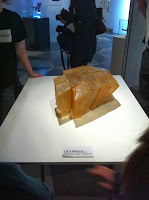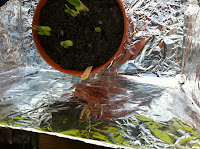 Over the past 13 weeks, our class created the sensory garden in the school's courtyard, and if I say so myself, it's looking pretty swell. We started our flowering experience as budding gardeners, weeding left, right and centre. Then we planted the various flowers for sight, sound, smell and taste in the designated sensory border and then some more in the circular flower beds. These beds were exposed to many different and beautiful species: lavender, tulips, hyacinths, amaryllis, phisilis, dahlia, pansies...but it has definitely all paid off! The courtyard looks neat and tidy and as the seasons change, so will the garden. It will turn into colourful, vibrant haven of pollen, only getting better and better as the other classes pick up where we left off.
Over the past 13 weeks, our class created the sensory garden in the school's courtyard, and if I say so myself, it's looking pretty swell. We started our flowering experience as budding gardeners, weeding left, right and centre. Then we planted the various flowers for sight, sound, smell and taste in the designated sensory border and then some more in the circular flower beds. These beds were exposed to many different and beautiful species: lavender, tulips, hyacinths, amaryllis, phisilis, dahlia, pansies...but it has definitely all paid off! The courtyard looks neat and tidy and as the seasons change, so will the garden. It will turn into colourful, vibrant haven of pollen, only getting better and better as the other classes pick up where we left off. However, this module wasn't all about planting. We learnt various green-thumb tips about composting, organic waste, biodegradable pots and several ways to be environmentally friendly - recycling for one! We got to show our creative side by making light boxes and newspaper pots. And we got the chance to create our own blog!
However, this module wasn't all about planting. We learnt various green-thumb tips about composting, organic waste, biodegradable pots and several ways to be environmentally friendly - recycling for one! We got to show our creative side by making light boxes and newspaper pots. And we got the chance to create our own blog! In all honesty, there was very little in this module that I didn't enjoy. I found it really interesting to learn about all the different types of plants and the different conditions they needed for growth, e.g bulbs are always planted in late Autumn/early Winter, and that Paper White Daffodils need to be left in the dark for the first few weeks after being planted. I liked learning about the different ways to compost at home and how to plant certain plants properly, like bulbs. I enjoyed doing the practical element of the module, that was actually planting the bulbs and different flowers. My favourite task was planting our Amaryllis bulb - De hÍde's Baby. It was nice to know that that plant is unique to our class, and while the other TY classes will have the chance plant all the things we did, none of them will be able to claim our baby. One thing I really didn't enjoy however was finding lovely big spiders in every plant I tried to up root...
In all honesty, there was very little in this module that I didn't enjoy. I found it really interesting to learn about all the different types of plants and the different conditions they needed for growth, e.g bulbs are always planted in late Autumn/early Winter, and that Paper White Daffodils need to be left in the dark for the first few weeks after being planted. I liked learning about the different ways to compost at home and how to plant certain plants properly, like bulbs. I enjoyed doing the practical element of the module, that was actually planting the bulbs and different flowers. My favourite task was planting our Amaryllis bulb - De hÍde's Baby. It was nice to know that that plant is unique to our class, and while the other TY classes will have the chance plant all the things we did, none of them will be able to claim our baby. One thing I really didn't enjoy however was finding lovely big spiders in every plant I tried to up root...I learnt a lot of new skills over the course of this module. I learnt that the correct way to plant bulbs is by planting them in a hole one and a half times there size. I learnt how to check if bulbs are stale, how to up root a plant fully, so as not to leave any part of the bulb behind. As a result this module, I can make light boxes for growing plants indoors. I can make biodegradable pots out of newspaper. I now know how to compost at home. In doing this blog, I have greatly improved my typing skills and my ability to write in general.
 If had was given the chance to do this module again, I would try to be more organised when it came to planting outside. While I think I managed well in performing this task, I think that if I had been slightly faster, I would have been able to plant more in the courtyard. However, as the first class to have this module this year, we had different kinds of work to some that the other classes mightn't have, e.g. we had several classes that just consisted of weeding the courtyard before we could plant anything. We also had to turn the soil before we planted because only the top layer has been exposed to the elements of the Summer months, therefore all the nutrients were in the bottom layers, leaving the top dry and infertile.
If had was given the chance to do this module again, I would try to be more organised when it came to planting outside. While I think I managed well in performing this task, I think that if I had been slightly faster, I would have been able to plant more in the courtyard. However, as the first class to have this module this year, we had different kinds of work to some that the other classes mightn't have, e.g. we had several classes that just consisted of weeding the courtyard before we could plant anything. We also had to turn the soil before we planted because only the top layer has been exposed to the elements of the Summer months, therefore all the nutrients were in the bottom layers, leaving the top dry and infertile. Overall, I have greatly enjoyed the experience that was the Horticulture module. I will definitely miss it on a Tuesday morning. I have learnt so much about gardening and plants over the course of this module that I think it is safe to say that I am an experienced Horticulturist! Without a doubt, I will be taking something from this module. I have always had a keen interest in gardening, which has just been revived by this experience. Although we are finished the module now, and we won't be in TY forever, it is nice to know that by the end of time in CCC, and even after when we leave school, there will always be a part of Rang de hÍde, class of 2013/14 left.
Overall, I have greatly enjoyed the experience that was the Horticulture module. I will definitely miss it on a Tuesday morning. I have learnt so much about gardening and plants over the course of this module that I think it is safe to say that I am an experienced Horticulturist! Without a doubt, I will be taking something from this module. I have always had a keen interest in gardening, which has just been revived by this experience. Although we are finished the module now, and we won't be in TY forever, it is nice to know that by the end of time in CCC, and even after when we leave school, there will always be a part of Rang de hÍde, class of 2013/14 left.We have made our mark, so it's time start making that a dent.

























